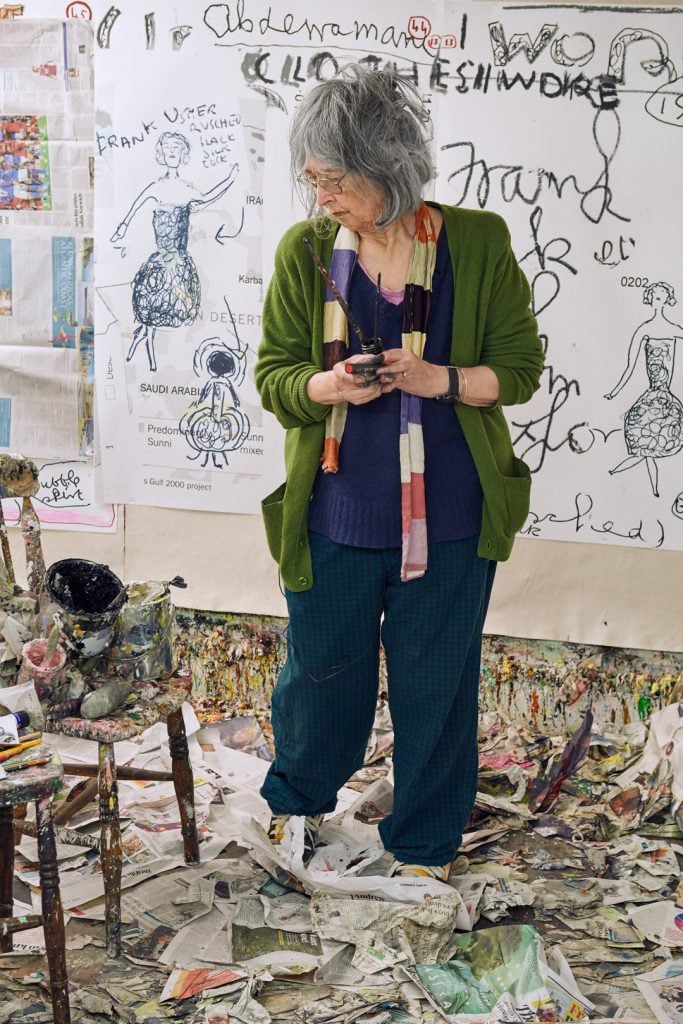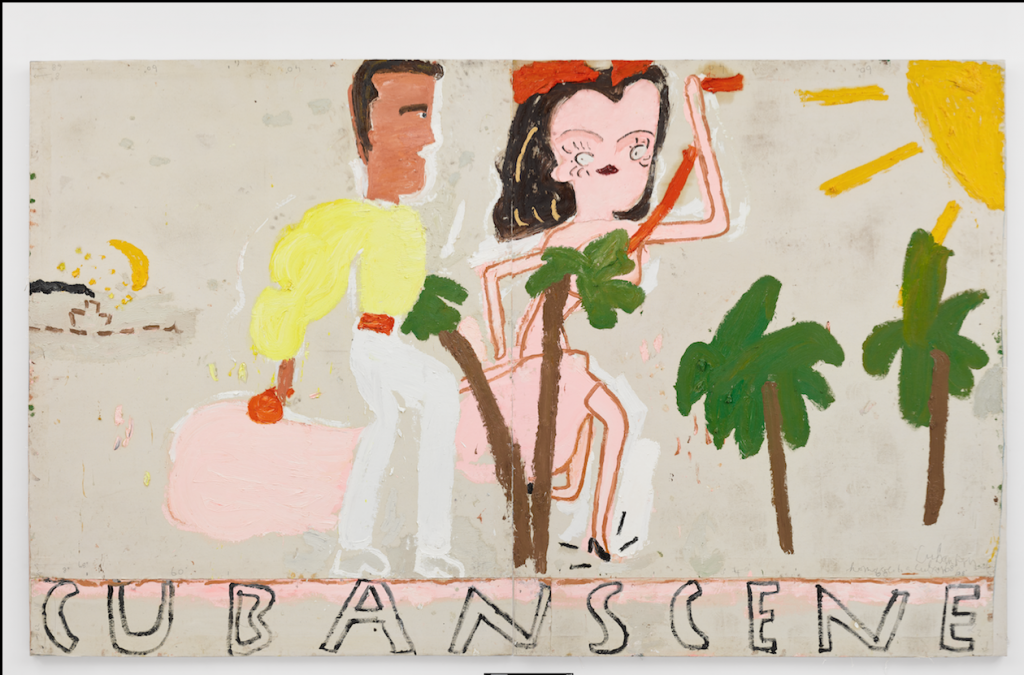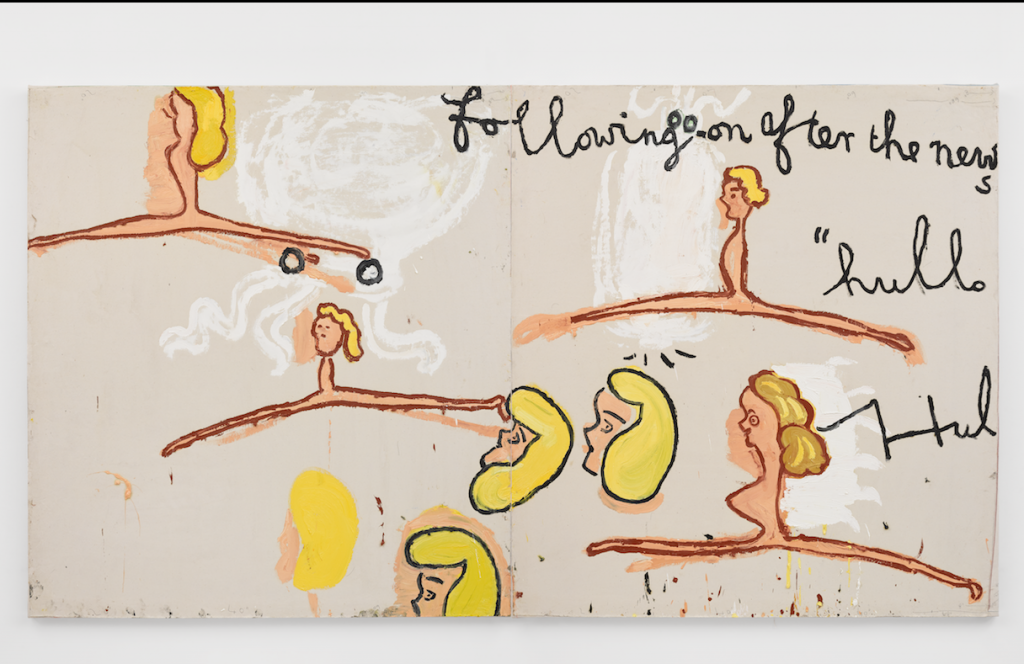People
At 86, British Artist Rose Wylie Doesn’t Really Know Why She’s Suddenly an Art Star. She’s Just Trying to Enjoy It
Wylie’s US solo debut has just opened at the Aspen Art Museum.

Wylie’s US solo debut has just opened at the Aspen Art Museum.

Naomi Rea

As the pandemic shuttered museums across the globe it kicked off a backlog of exhibition planning, leaving many artists rightfully worried that their newly “postponed” show might ultimately become a canceled one.
The artist Rose Wylie was one of the lucky ones. At 86, Wylie is a treasure of the UK art world, though she only gained market traction relatively late in her career (the mega-gallerist David Zwirner took her on in 2017). Her first US museum solo, at the Aspen Art Museum, was initially slated to open in March, but was finally able to open this month and will run through November.
Titled “where i am and was,” the show tracks Wylie’s career through 14 paintings from the 1990s through to the present, as well as a number of preparatory drawings, concept sketches, and ephemera.
“The nice thing about museum shows is that you can put in works which are sold and dispersed around the place,” Wylie tells Artnet News. “You can get together work for the quality of the work.”

Rose Wylie, City Road (1999). ©Rose Wylie. Courtesy of the artist and David Zwirner.
I spoke to Wylie from her home in Kent. Her age puts her in a group of the population that is more vulnerable to the coronavirus, but she is not at home just because of the pandemic.
“It’s easy to say that I would go [to the opening] under normal circumstances, but I wouldn’t,” Wylie says. The artist doesn’t like flying, so she doesn’t go to private views outside of driving distance. She hopes that one thing to come out of the pandemic is a reversal on the amount of air travel that takes place in the art world.

Rose Wylie, Cuban Scene, Smoke (2016). ©Rose Wylie. Courtesy of the artist and David Zwirner.
The artist is spending lockdown at home, where she has been hard at work in her studio. “I’m in wonderfully complete isolation with my cat,” she says. Pete, whom she says is “nearly human,” is her constant companion.
“One of the positive things is there are fewer interruptions,” she says. But the harsh realities of the outside world find a way to intrude, and the artist throws herself into work to cope. “I think for me painting is an escape from all that, because it’s completely separate, even if you might use it, it’s under your control.”
Wylie’s paintings take inspiration from things she encounters in her day to day life, such as newspapers, art history, films, and even advertising. “It’s not to do with the psychology or the plot or anything, it’s just the visual excitement,” she says. “Something stops me in my tracks, and I think I’ll go make a drawing of it because I simply want to remember it.”
She has just finished a new painting inspired by illuminated manuscripts that she stumbled across while surfing the web.
The paintings on view in Aspen speak to some of the constants throughout Wylie’s career, including explorations of the power of celebrity and how women are represented in visual culture.
A visitor might recognize several faces on view, reproduced in the artist’s expressive and colorful strokes, including the star tennis player Serena Williams. Wylie says that she has returned to Williams as a subject several times because she likes the way the tennis player counters expectations about how she “should” look.
“It’s easy to misinterpret what I am doing,” Wylie says. “It’s not because she is a woman, and it is not because she is Black, but she seems to be someone who is herself, her physique is very powerful, and she is a superb player.”

Rose Wylie, Aston Villa (2019). ©Rose Wylie. Courtesy the artist and David Zwirner.
The artist has also turned her brush to some famous soccer players, from Wayne Rooney to Thierry Henry, inspired from the days when she used to watch Match of the Day with her husband in the evenings (he died in 2014). “People think I’m crazy about football—I’m not, but they are kind of like gods out there, people know and they recognize them, so it is an entry point into the work for them.”
The exhibition title prompts me to ask Wylie about how the reception of her work has changed over the years.
“For a long time, I painted and no one paid anything the slightest attention,” she says. “I never quite understood why because in a sense I’m completely mainstream.” Wylie has an art school background, complete with a Master’s degree from the Royal College of Art. But for a long time her paintings sat gathering dust on her studio floor. She muses that her more intuitive and non-academic style did not speak to people, until all of a sudden it did.
“I don’t know why since I hadn’t changed and the work hadn’t changed, but institutions, gallerists, and collectors changed their minds. It beats me,” Wylie says.

Rose Wylie, Hullo, Hullo, Following on After the News (2017). ©Rose Wylie. Courtesy of the artist and David Zwirner.
Though she acknowledges that museums have come a long way in improving the gender balance of their collections, she says there is still further to go. “When I was an art student, the stuff in museums was all male,” she says. “It’s still not as it should be, but it’s better.”
Being thrust into the spotlight has been invigorating for the artist, who says she is comforted knowing that the new work she makes will go up in a gallery rather than languish in the studio. Having the backing of a serious gallery like Zwirner also seems to have helped collectors to see the quality in her work.
But the artist gets irritated when people suggest the belated attention has come because she is older. “I don’t want to be known for my age, it’s irrelevant, and I don’t want one of the justifications to be because the paintings are done by an old women,” she says. “It should be the work that gets the attention.”
Coming up next, Wylie will have another solo exhibition at the Hangaram Art Museum at Seoul Arts Center in December. Next March she will open her first solo exhibition with David Zwirner in New York.
“Rose Wylie: where i am and was” is on view at Aspen Art Museum through November 1.